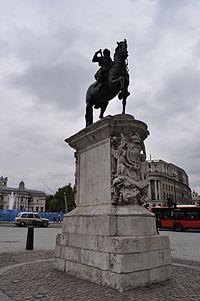Charing Cross
| Charing Cross | |
|---|---|
 Charing Cross Roundabout, showing the Statue of Charles I, situated on the site of the original Eleanor Cross |
|
| Charing Cross shown within Greater London | |
| OS grid reference | TQ302804 |
| London borough | |
| Ceremonial county | Greater London |
| Region | |
| Country | England |
| Sovereign state | United Kingdom |
| Post town | LONDON |
| Postcode district | WC2 |
| Dialling code | 020 |
| Police | Metropolitan |
| Fire | London |
| Ambulance | London |
| EU Parliament | London |
| UK Parliament | |
| London Assembly | |
Charing Cross (/ˌtʃærɪŋ ˈkrɒs/) denotes the junction of Strand, Whitehall and Cockspur Street, just south of Trafalgar Square in central London. It gives its name to several landmarks, including Charing Cross railway station, one of the main London rail terminals.
Charing Cross is named after the Eleanor cross that stood on the site, in what was once the hamlet of Charing. The site of the cross has been occupied since 1675 by an equestrian statue of King Charles I. A loose Victorian replica of the medieval cross, the Queen Eleanor Memorial Cross, was erected a short distance to the east outside the railway station.
Until 1931, "Charing Cross" referred to the part of Whitehall between Great Scotland Yard and Trafalgar Square. At least one property retains a "Charing Cross" postal address: Drummonds Bank, on the corner of Whitehall and The Mall, which is designated "49 Charing Cross" (not to be confused with Charing Cross Road).
Since the early 19th century, Charing Cross has often been regarded as the notional "centre of London", and is now the point used to measure distances from London.
...
Wikipedia

